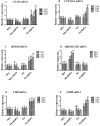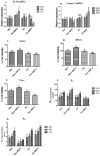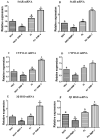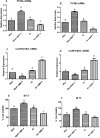Modulation of granulosa cell function via CRISPR-Cas fuelled editing of BMPR-IB gene in goats (Capra hircus)
- PMID: 33235250
- PMCID: PMC7686318
- DOI: 10.1038/s41598-020-77596-9
Modulation of granulosa cell function via CRISPR-Cas fuelled editing of BMPR-IB gene in goats (Capra hircus)
Abstract
BMPs are multifunctional growth factors implicated in regulating the ovarian function as key intra-ovarian factors. Biological effects of BMPs are mediated through binding with membrane bound receptors like BMPR-IB and initiating downstream Smad signaling pathway. FecB mutation, regarded as a loss of function mutation in the BMPR-IB gene was identified in certain sheep breeds having high fecundity. Similar type of fecundity genes in goats have not been discovered so far. Hence, the current study was designed to investigate the effects of BMPR-IB gene modulation on granulosa cell function in goats. The BMPR-IB gene was knocked out using CRISPR-Cas technology in granulosa cells and cultured in vitro with BMP-4 stimulation for three different durations In addition, the FecB mutation was introduced in the BMPR-IB gene applying Easi-CRISPR followed by BMP-4/7 stimulation for 72 h. Steroidogenesis and cell viability were studied to explore the granulosa cell function on BMPR-IB gene modulation. BMPRs were found to be expressed stage specifically in granulosa cells of goats. Higher transcriptional abundance of R-Smads, LHR and FSHR indicating sensitisation of Smad signaling and increased gonadotropin sensitivity along with a significant reduction in the cell proliferation and viability was observed in granulosa cells upon BMPR-IB modulation. The inhibitory action of BMP-4/7 on P4 secretion was abolished in both KO and KI cells. Altogether, the study has revealed an altered Smad signaling, steroidogenesis and cell viability upon modulation of BMPR-IB gene in granulosa cells similar to that are documented in sheep breeds carrying the FecB mutation.
Conflict of interest statement
The authors declare no competing interests.
Figures










Similar articles
-
Differential expression of BMP/SMAD signaling and ovarian-associated genes in the granulosa cells of FecB introgressed GMM sheep.Syst Biol Reprod Med. 2020 Jun;66(3):185-201. doi: 10.1080/19396368.2019.1695977. Epub 2020 Jan 18. Syst Biol Reprod Med. 2020. PMID: 31957496
-
BMPs and BMPRs in chicken ovary and effects of BMP-4 and -7 on granulosa cell proliferation and progesterone production in vitro.Am J Physiol Endocrinol Metab. 2003 Nov;285(5):E973-83. doi: 10.1152/ajpendo.00104.2003. Epub 2003 Jul 29. Am J Physiol Endocrinol Metab. 2003. PMID: 12888485
-
Disruption of the sheep BMPR-IB gene by CRISPR/Cas9 in in vitro-produced embryos.Theriogenology. 2017 Mar 15;91:163-172.e2. doi: 10.1016/j.theriogenology.2016.10.025. Epub 2016 Nov 9. Theriogenology. 2017. PMID: 28108032
-
Bone morphogenetic proteins.Growth Factors. 2004 Dec;22(4):233-41. doi: 10.1080/08977190412331279890. Growth Factors. 2004. PMID: 15621726 Review.
-
Regulation of ovarian folliculogenesis by IGF and BMP system in domestic animals.Domest Anim Endocrinol. 2002 Jul;23(1-2):139-54. doi: 10.1016/s0739-7240(02)00152-2. Domest Anim Endocrinol. 2002. PMID: 12142233 Review.
Cited by
-
The Role of BMP Signaling in Female Reproductive System Development and Function.Int J Mol Sci. 2021 Nov 3;22(21):11927. doi: 10.3390/ijms222111927. Int J Mol Sci. 2021. PMID: 34769360 Free PMC article. Review.
-
Dynamic changes in cellular atlases and communication patterns within yak ovaries across diverse reproductive states unveiled by single-cell analysis.Front Cell Dev Biol. 2024 Aug 29;12:1444706. doi: 10.3389/fcell.2024.1444706. eCollection 2024. Front Cell Dev Biol. 2024. PMID: 39268087 Free PMC article.
-
Uterus proliferative period ceRNA network of Yunshang black goat reveals candidate genes on different kidding number trait.Front Endocrinol (Lausanne). 2023 May 12;14:1165409. doi: 10.3389/fendo.2023.1165409. eCollection 2023. Front Endocrinol (Lausanne). 2023. PMID: 37251683 Free PMC article.
-
Detection of mRNA Expression and Copy Number Variations Within the Goat Fec B Gene Associated With Litter Size.Front Vet Sci. 2021 Oct 18;8:758705. doi: 10.3389/fvets.2021.758705. eCollection 2021. Front Vet Sci. 2021. PMID: 34733908 Free PMC article.
-
The Roles of GDF-9, BMP-15, BMP-4 and EMMPRIN in Folliculogenesis and In Vitro Fertilization.J Clin Med. 2024 Jun 27;13(13):3775. doi: 10.3390/jcm13133775. J Clin Med. 2024. PMID: 38999341 Free PMC article. Review.
References
-
- Hafez ESE, Hafez B. Folliculogenesis, egg maturation, and ovulation. In: Hafez B, Hafez E, editors. Reproduction in Farm Animals. Philadelphia: Lippincott Williams & Wilkins; 2000. pp. 68–81.
-
- Telfer EE. The development of methods for isolation and culture of preantral follicles from bovine and porcine ovaries. Theriogenology. 1996;45:101–110. doi: 10.1016/0093-691X(95)00359-G. - DOI
-
- Sharma GT, Majumdar AC. Control of follicular steroidogenesis in early-and late-luteal phase goat ovaries. Small Ruminant Res. 1999;34:111–117. doi: 10.1016/S0921-4488(99)00006-1. - DOI
-
- McGee EA, Hsueh AJ. Initial and cyclic recruitment of ovarian follicles. Endocr. Rev. 2000;21:200–214. - PubMed
MeSH terms
Substances
LinkOut - more resources
Full Text Sources
Research Materials
Miscellaneous

